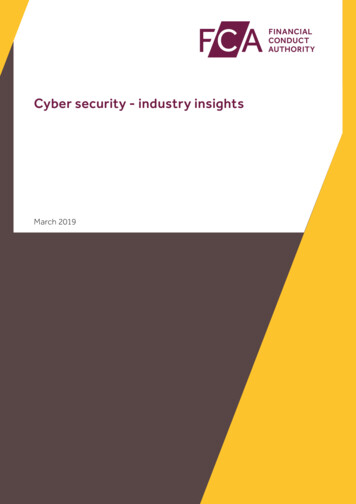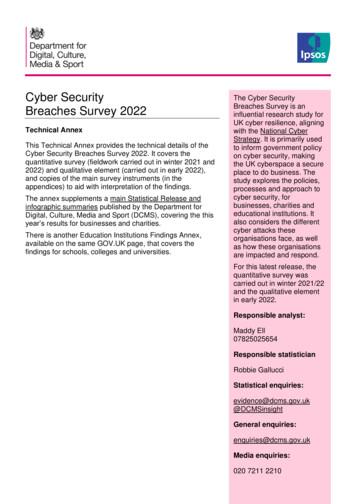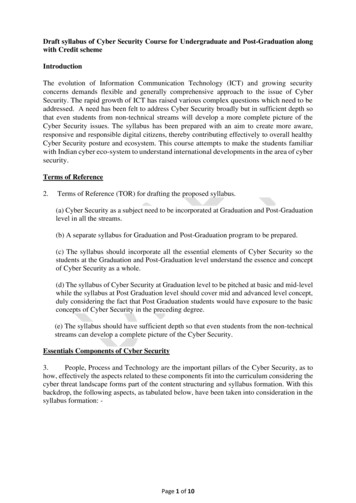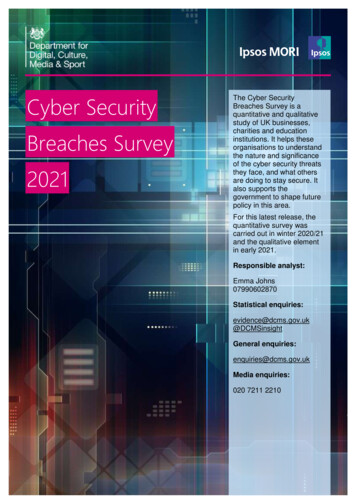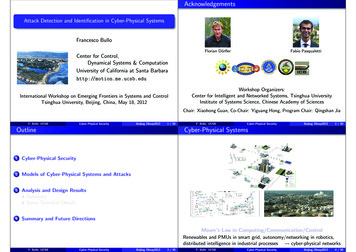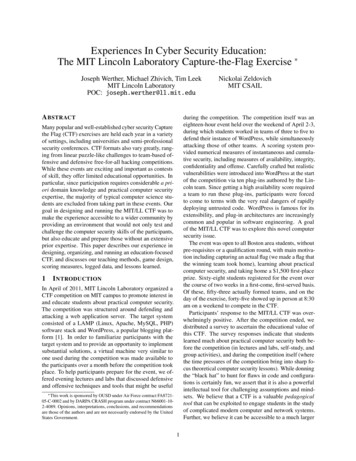
Transcription
Experiences In Cyber Security Education:The MIT Lincoln Laboratory Capture-the-Flag Exercise Joseph Werther, Michael Zhivich, Tim LeekMIT Lincoln LaboratoryPOC: joseph.werther@ll.mit.eduA BSTRACTduring the competition. The competition itself was aneighteen-hour event held over the weekend of April 2-3,during which students worked in teams of three to five todefend their instance of WordPress, while simultaneouslyattacking those of other teams. A scoring system provided numerical measures of instantaneous and cumulative security, including measures of availability, integrity,confidentiality and offense. Carefully crafted but realisticvulnerabilities were introduced into WordPress at the startof the competition via ten plug-ins authored by the Lincoln team. Since getting a high availability score requireda team to run these plug-ins, participants were forcedto come to terms with the very real dangers of rapidlydeploying untrusted code. WordPress is famous for itsextensibility, and plug-in architectures are increasinglycommon and popular in software engineering. A goalof the MIT/LL CTF was to explore this novel computersecurity issue.The event was open to all Boston area students, withoutpre-requisites or a qualification round, with main motivation including capturing an actual flag (we made a flag thatthe winning team took home), learning about practicalcomputer security, and taking home a 1,500 first-placeprize. Sixty-eight students registered for the event overthe course of two weeks in a first-come, first-served basis.Of these, fifty-three actually formed teams, and on theday of the exercise, forty-five showed up in person at 8:30am on a weekend to compete in the CTF.Participants’ response to the MIT/LL CTF was overwhelmingly positive. After the competition ended, wedistributed a survey to ascertain the educational value ofthis CTF. The survey responses indicate that studentslearned much about practical computer security both before the competition (in lectures and labs, self-study, andgroup activities), and during the competition itself (wherethe time pressures of the competition bring into sharp focus theoretical computer security lessons). While donningthe “black hat” to hunt for flaws in code and configurations is certainly fun, we assert that it is also a powerfulintellectual tool for challenging assumptions and mindsets. We believe that a CTF is a valuable pedagogicaltool that can be exploited to engage students in the studyof complicated modern computer and network systems.Further, we believe it can be accessible to a much largerMany popular and well-established cyber security Capturethe Flag (CTF) exercises are held each year in a varietyof settings, including universities and semi-professionalsecurity conferences. CTF formats also vary greatly, ranging from linear puzzle-like challenges to team-based offensive and defensive free-for-all hacking competitions.While these events are exciting and important as contestsof skill, they offer limited educational opportunities. Inparticular, since participation requires considerable a priori domain knowledge and practical computer securityexpertise, the majority of typical computer science students are excluded from taking part in these events. Ourgoal in designing and running the MIT/LL CTF was tomake the experience accessible to a wider community byproviding an environment that would not only test andchallenge the computer security skills of the participants,but also educate and prepare those without an extensiveprior expertise. This paper describes our experience indesigning, organizing, and running an education-focusedCTF, and discusses our teaching methods, game design,scoring measures, logged data, and lessons learned.1Nickolai ZeldovichMIT CSAILI NTRODUCTIONIn April of 2011, MIT Lincoln Laboratory organized aCTF competition on MIT campus to promote interest inand educate students about practical computer security.The competition was structured around defending andattacking a web application server. The target systemconsisted of a LAMP (Linux, Apache, MySQL, PHP)software stack and WordPress, a popular blogging platform [1]. In order to familiarize participants with thetarget system and to provide an opportunity to implementsubstantial solutions, a virtual machine very similar toone used during the competition was made available tothe participants over a month before the competition tookplace. To help participants prepare for the event, we offered evening lectures and labs that discussed defensiveand offensive techniques and tools that might be useful This work is sponsored by OUSD under Air Force contract FA872105-C-0002 and by DARPA CRASH program under contract N66001-102-4089. Opinions, interpretations, conclusions, and recommendationsare those of the authors and are not necessarily endorsed by the UnitedStates Government.1
subset of computer science students than a traditionalCTF.This paper discusses our experiences of designing andrunning the MIT/LL CTF. We examine the successesand failures, related to both our educational goals andsystem design, and share our overall conclusions withrespect to future improvements. Section 2 discusses ourpedagogical approach, and Section 3 describes the educational methods and lectures used for the CTF. Section 4examines the choices made with respect to selecting thecomponents and techniques used in designing the gameand evaluating participants’ progress. Section 5 coversthe evaluation metrics used to assess teams during thecompetition. Section 6 analyzes data gathered during andafter the event including team scoring trends, reactionsto changes in the importance of metrics during the game,and survey results from the participants. Section 7 discusses related CTF exercises and how the MIT/LL CTFis different. Finally, Section 8 offers lessons learned bythe MIT/LL CTF staff, and how we plan to change theevent in future iterations.We are certainly not the first to consider offensive components to be crucial to learning practical computer security. O’Connor et al [11] suggest that framing study ofgeneral computer science concepts from a perspective ofan adversary encourages student participation and interest.Moreover, they argue that framing the problem in termsof security (e.g., forensics) makes learning about othertopics, such as file system formats, much more exciting.George Mason University explored the merits of havingstudents create offensive test cases to exploit the codethey developed as part of class assignments [8]. In doingso, they found that the offensive mindset led students todiscover vulnerabilities not found through other testingmethods. Bratus [2] also argues for adding componentsof adversarial, hacker mindset to the traditional computerscience curriculum due to the low-level knowledge it imparts, and its necessity in understanding and effectivelyimplementing secure systems. In designing our CTF, wesought to enable a wider range of participants to benefitfrom this approach to computer security education.32P EDAGOGICAL A PPROACHE DUCATIONAL D ESIGNSince our goal was to create not only another CTF exercise, but also a pedagogic tool for teaching computersecurity, we incorporated several educational components,in the form of lectures and labs, into the MIT/LL CTF. Intotal, we offered five classes in the month preceding thecompetition.The first lecture provided an overview of the CTFgame, its mechanics and rules. As part of this description,we presented the game platform and architecture (Linux,x86), as well as the intended target – the WordPress content management system. We also explained and justifiedthe scoring system, with suitable measures of confidentiality, integrity, availability and offense (see Section 5).This meeting allowed those who had not taken part in aCTF exercise before to understand the game better andask questions.In the second class, we presented the basics of webapplications, the WordPress API, and some of the fundamental ways in which its design makes computer securitydifficult. We did not teach PHP, JavaScript or SQL, eventhough WordPress makes use of all three, as these detailscould easily be mastered by the general computer science student in self-study. The intent was not to educatestudents to the point that they might go off and write aweb application; rather, we hoped to orient them in this(perhaps unfamiliar) terrain, providing an overview ofthe target and sketching the security issues for them toconsider on their own.The third class covered various aspects of Linux serversecurity, also in lecture form. Topics ranged from highlevel concepts, including the principle of least privilege,multi-layer defense and attack surface, to low-level dis-Students learn about computer security in a number ofways. Reading conference papers, journal articles, andbooks, for instance, allows students to acquire valuabletheoretical apparatus and learn what has been tried before.Designing and implementing defensive systems and offensive tools is also valuable, as it requires the applicationof abstract knowledge to build real working solutions.In addition to these fairly traditional educational avenues, we believe that practicing defending and attackingreal computer systems in real time is also of immenseeducational value, and that it offers lessons that can’teffectively be taught in a classroom. A CTF event is aplayground in which students can fail or succeed safely atcomputer defense, and where it is permissible to engagein attack, without fear of consequences or reprisal. Webelieve it is crucial for CTF events to include an offensivecomponent, not only because students find it exhilarating,but because it also challenges flawed reasoning and assumptions in tools, techniques, and systems, and leads to adeeper understanding of computer science in general [6].Despite the significant educational potential of a CTF,many potential participants (i.e., those with a general computer science background or even a few computer securityclasses under their belt) perceive there to be a high barrierto entry. Unfortunately, they are often right: participatingin and learning from a typical CTF competition requiressignificant skills and background knowledge. For participants with inadequate skills, it can be frustrating andbewildering, as their systems are compromised quicklyand repeatedly. They are lucky if they even know whathas happened, let alone why.2
cussions of practical details such as firewalls, applicationconfiguration, package management and setuid binaries. A number of standard tools and packages suchas AppArmor, Tripwire, and fail2ban were also explained. Additionally, MIT’s volunteer student-run computing group SIPB presented a case study in securingthe web application (scripts.mit.edu) and virtual machine (xvm.mit.edu) hosting services provided to theMIT community.The fourth lecture discussed web application exploitation techniques including SQL Injection, Cross-SiteScripting, and other server-side and client-side attackvectors. Each topic was addressed from the aspects ofvulnerability discovery, exploitation, and mitigation. Itwas our hope that approaching each issue from all threeangles would help the participants build better tools in theweeks leading up to the competition.The final class consisted of a lab in which the participants were asked to work through computer securitychallenges with the help of the organizers. For this exercise, we used Google Gruyere [7]. This site allowed eachstudent to stand up a separate instance of the exercisesand practice finding and exploiting the plethora of issuesdiscussed in the previous lecture. By allowing participants to build exploits and actually apply the knowledgethey gained through the previous lectures, we hope theygained perspective on the tools they would build or usein the coming weeks to prevent similar intrusions fromsucceeding on their server.In addition to the classes, a mailing list and wiki wereset up to provide information and answer questions. Afterthe release of the competition VM (both before and afterlectures and lab), participants posed a number of questions about server configuration, tool use, and defensiveand offensive strategies using these resources. We alsoheld a post mortem session right after the competitionto discuss the vulnerabilities that we introduced into theplug-ins provided and to give teams an opportunity toexplain their strategies, including how they found and exploited vulnerabilities. We used this forum also to solicitfeedback about the mechanics and implementation of thecompetition itself.4code of the system. An easy way to do this was to focuson web application security.Having chosen the game genre, the next decision wasselecting an open source or custom-written web application framework. We believed that the game would bemore meaningful to the participants if we used realistic, commercial off-the-shelf (COTS) software during theCTF, since it would allow them to build reusable expertise for a popular software package that they are likelyto encounter again elsewhere. With this in mind we setout to select a common web application framework thatwould enable our CTF to be educational, well-designed,and fun to play. After considering several candidates, thePHP-based Content Management System (CMS) WordPress [1] was selected as the CTF’s base architecture.4.2One of the main requirements in selecting a web application framework was modularity. We needed a robust wayto introduce new vulnerabilities that could be exploitedby competition participants that could not be discoveredby simple source code “diff”. A plug-in architecture,especially one as flexible and extensively used as in WordPress, allowed us to create new functionality that featuredcarefully crafted but realistic vulnerabilities. At the sametime, this architecture enabled us to provide the participants with the basic framework (i.e., LAMP server withWordPress) ahead of the competition without revealingany details of the plug-ins we were building. Finally, separating our challenges into different plug-ins enabled easydivision of labor.Plug-ins are used extensively, particularly in web applications. We felt that the dynamics of acquiring untrustedcode, examining it for potential flaws, fixing the ones thatcan be easily found and providing some kind of sandboxing or code isolation as a fail-safe was a realistic strategythat system administrators might employ. Formulating agame around this dynamic enabled participants to practiceseveral important practical computer security skills, including source code auditing, fuzzing or web applicationpenetration testing to find vulnerabilities, patching codewithout removing functionality, and configuring appropriate sandboxing mechanisms.E XERCISE D ESIGN4.3This section covers design decisions made while planningthe CTF and its component challenges.4.1Modular Game DesignPre-release of Select Game ContentTo enable students to create significant solutions wewanted to release as much of the CTF content ahead of thecompetition as possible, without releasing the challengesthemselves. By selecting a modular framework, we wereable to withhold all of the challenges explicitly writtenfor the CTF while providing a virtual machine to teamsa month ahead of time. Since the distributed VM wasalmost identical to the one deployed at the competition,participating teams were encouraged to build defensiveTarget SelectionIn order to design a CTF that carried an academic flavor, we realized that challenges based on compiled binaries would require an unacceptably large amount of priorknowledge and thus contradict our pedagogical goals laidout in Section 2. As such, we chose a CTF setting thatwould naturally allow the participants access to the source3
Varying values for Wd , WA , WI and WC provided muchneeded flexibility for simulating scenarios with differentimportance assigned to the corresponding properties. Therest of this section describes how each of the score components was measured.tools and scripts to lock down their servers, while verifying the base server configuration was secure.Furthermore, since WordPress has a large set of publicly available plug-ins, many of which have publishedsecurity vulnerabilities, we were able to further augment the pre-released virtual machine with representative sample plug-ins. Three vulnerable WordPress plugins and corresponding exploit code were gathered fromwww.exploit-db.com and installed into the VM’s WordPress instance. This provided a proxy for what the teamswould see during the game, thus enabling teams to buildand test defensive measures and sandboxing implementations before the competition began.4.45.1Each team’s availability score was measured using a grading engine with a module written for each plug-in, with anadditional module to evaluate WordPress’s basic functionality. Scores from each grading module were combinedinto a weighted average, according to an assigned importance of each plug-in. For this competition, all functionality was weighted evenly; however, these weights couldbe easily adjusted to reflect the difficulty of securing aplug-in that provides some complicated functionality.During the competition each team’s website was evaluated on 5-10 minute intervals. A team’s overall availability score was calculated as the mean of all availabilityscores to date.Simulating the Real WorldIn addition to supporting the pedagogical goals describedabove, we aimed to emulate the dynamic nature of realworld operations. Business pressures require IT infrastructure to be nimble and provide new functionality onshort notice. To simulate these requirements during theCTF, we released one batch of new plug-ins at the beginning of the competition, and another batch near the endof the first day. Because plug-ins provided independentfunctionality, teams could choose to run some of them,but not others, thus giving them time to review and hardennew plug-ins; however, any delay in enabling plug-inscorresponded to sacrifices in the availability score.4.55.2Flag-based MetricsEvery 15 minutes, flags (128-character alphanumericstrings) were deposited into the file system and databaseon each team’s server. If opposing teams captured theseflags, they could submit them to the scoreboard system.Flags were assigned a point value corresponding to theperceived difficulty and level of access needed to acquirethe flag. By providing flags of varying difficulty, wehoped that teams try to escalate privilege to gain higherlevels of access than those afforded by the more basicexploits available in the game. Following the insertion offlags into each system, the scoring bot would wait a random period and check whether the flags were unaltered.The confidentiality, integrity and offense score components were derived from the flag dropping and evaluationsystem described above. Integrity was calculated as thefraction of flags that were unaltered after the random sleepperiod; if the VM was inaccessible, a score of zero wasreported, as the state of the flags could not be determined.The instantaneous integrity scores were averaged togetherto produce the integrity subscore.Confidentiality and offense were closely linked portions of each team’s score. Confidentiality was a runningrecord of the percentage of flag points assigned to a teamthat had not yet been submitted by an opposing team foroffensive points. Conversely, offense was calculated asthe raw percentage of flags that a team did not own themselves but submitted to the scoreboard for points. Unlikeavailability and integrity scores, which were immediatelycomputed by the grading system, the confidentiality andoffense scores were based on flags submitted by differentteams. Since a flag could be submitted to the scoreboardby a team any time after that flag entered the CTF ecosys-Selecting ParticipantsGiven the open nature of the MIT/LL CTF, we did notrequire any qualifications of our participants, aside frombeing enrolled in an undergraduate or graduate level program at a Boston-area university and willingness to spendthe weekend competing in the CTF. We encouraged participants to form teams of at least three members, as wefelt that competing with fewer people would put the teamat a significant disadvantage. Our resulting participantpool was comprised of undergraduates from MIT, Northeastern University, Boston University, Olin College, University of Massachusetts (Boston), and Wellesley College,divided into (some multi-institutional) teams of three tofive members.5Functionality-based MetricsS CORINGIn order to evaluate the teams’ performance during theCTF, we separately assessed each team’s ability to defendtheir server (the Defense subscore) and to capture otherteam’s flags (the Offense subscore). The defense portionof the score was itself derived from three measures: confidentiality (C), integrity (I), and availability (A) that werecombined using weights WC , WI , and WA .Score Wd Defense (1 Wd ) OffenseDefense WC C WI I WA A4
availability was worth only 16 of the total score, and theteam’s confidentiality and integrity scores improved withmost paths to attack removed. Furthermore, this strategyenabled the entire team to focus on offense.Since this was not the game equilibrium we were looking for, we adjusted the grading weights to shift the balance of the game back in favor of keeping the web serversrunning. On the second day, we announced that new scoring weights were Wd .80 and WA .80, thus makingavailability worth now a hefty 64% of the total score. Newweights, of course, did not apply retro-actively to scoresobtained on the first day.Given this change in scoring metric, we would haveexpected to see availability rise during the second half ofthe competition. We would have also expected resourcesfrom offense-related activities to be diverted to defense;thus, we expected to see offense scores decrease in thesecond half of the competition as well. However, theresults showed a more complicated picture, as we nowdiscuss.tem, it was impossible to instantaneously tell when agiven team’s confidentiality was compromised.5.3Situational AwarenessIn an effort to provide situational awareness, the scoreboard presented two informational screens to each team.The errors view provided access to availability and flagrotation errors. Each availability error was tagged withthe corresponding plug-in and a timestamp. Flag rotation errors indicated to the team when a flag could not bedropped onto their system, and whether it was a databaseor a file system flag. With both of these pieces of information, teams were adequately able to detect and fix brokenfunctionality on their system.The grading view provided each team with a breakdown of their scores in a more granular fashion. The lastten instantaneous integrity and availability scores weredisplayed to each team, enabling them to identify whentheir level of service had been adversely affected. Confidentiality was displayed as a number of flag-points notscored by other teams out of the total number of flagpoints assigned to the specific team. Conversely, offensewas displayed as the total number of flag points scored outof the total number of flag points in the CTF not belongingto the specified team. We considered offering informationabout confidentiality and offense score in a similar fashion to integrity, but realized that data was not meaningfulbecause of the practice of flag hoarding – i.e. collectingflags from an opponent’s VM but not submitting theminstantly to conceal the intrusion.66.1.1Figure 1 (left) shows the instantaneous availability for thetop 5 teams (given the final standings).The general trends in availability scores for the first dayseem to imply that two strategies were in place. Someteams (DROPTABLES, Ohack, and Pwnies) seem to haveenabled the web server and plug-ins at the beginning ofcompetition and thus suffered from exploits throughoutthe day. Other teams (CookieMonster and GTFO) disabled the plug-ins at the beginning of the day, thus payingthe cost in decreased availability; however, once they figured out some way to secure them, the web servers wereturned back on.On the second day, the picture is quite different.DROPTABLES and GTFO (1st and 2nd place finalists,respectively) battle to keep their availability up (presumably while under heavy attack). CookieMonster starts outwith high availability, but drops rather precipitously asthe team’s web server is owned and eventually destroyedbeyond recovery. Pwnies and Ohack struggle against attacks as well, but do manage to get the plug-ins functionaltowards the end of the competition. While we are notseeing a clear trend demonstrating that availability washigher during the second day of the competition, it is evident that the teams were trying to get their availabilityback up, even if some did not succeed.DATA A NALYSISIn our CTF, we collected data from two different sources:the availability, integrity, confidentiality and offensescores aggregated during the competition itself, and participant surveys distributed after the competition. Throughanalysis of the scoreboard information we can gain insightinto the way the scoring function affected and incentivizedcertain actions within the game, while survey responsesprovide a way to gauge effectiveness of the exercise ineducating, challenging, and enticing participants into thefield of computer security.6.1Availability ScoresScoring Data AnalysisThe scoring function discussed in Section 5 included adjustable weights to enable us to shift the balance of thegameplay if we deemed the CTF to be too focused onsome aspect of defense or offense. On day one, we setWd 12 (thus giving even weight to defense and offensecomponents), and set W{A,I,C} 13 . In this configuration, we discovered that the teams shut off the web server(or turned it on only during scoring runs), thus removing most obvious pathways an adversary would use totake over the system. This strategy was cost-effective, as6.1.2Offense ScoresFigure 1 (right) shows the cumulative running averageof the offense score for the two days of the competition(again, just for the top 5 teams). Because flag hoarding isallowed by our system, there is no “instantaneous” offensescore – this score necessarily carries the memory of the5
Figure 1: Instantaneous availability (left) and offense (right) scores for the top 5 ranked teams on day 1 (top) and day 2 (bottom). The plateausbetween 13:00-14:00 and 17:00-18:00 represent lunch and dinner breaks, respectively. The competition ended at 21:00 on day 1 and 19:00 on day 2.entire competition. Here, we expected to see a decreasein offense activity on day two, as teams’ resources areredirected to defense to ensure highest availability.On day one, Ohack and Pwnies dominate the offensive landscape (at the expense of their availability scores),while DROPTABLES, CookieMonster and GTFO spendless time on offense and thus provide higher availability (at least before the dinner break). On day two,Ohack again dominates all other teams in total numberof flags submitted. The sharp jump for both Ohack andPwnies coincides with our announcement that the scoringweights are changing – therefore, any flags that were being hoarded are submitted to the scoreboard as soon aspossible. After that, offensive scores decline as the teamspresumably spend more effort on defense, with the exception of GTFO, whose offense score increases throughoutthe day.Overall, the data supports the notion that teams refocused their efforts from offense to defense due to thechange in scoring metric. The results are somewhat muddled by the fact that the teams figured out several vulnerabilities by the time day two started, so maintaining ahigher availability was more difficult.6.2computer security skill, but their comments indicate thatthey may have been over-confident in their skill levelbefore the competition began.When polled about interest in a computer security career both before and after the event, respondents displayedan average of 1.1 point increase in interest (again, on a10-point scale). This is likely due to the fact that manyof those who responded stated that they had a 10 out of10 interest in a computer security career even before thecompetition.When asked to select the lectures that they found to bemost helpful, the Linux Server Lockdown was the mostpopular (13 votes), closely followed by Web ApplicationExploitation (11 votes). Survey comments indicated thatrespondents found several techniques presented duringour lectures useful. From the Linux Server Lockdown lecture, Apache’s mod security was mentioned as beinghelpful by several respondents. Additionally, respondentsused fail2ban and Tripwire for detecting attacks, albeit some mentioned that Tripwire consumed too manysystem resources and had to be turned off. Surveys alsoindicated that knowledge of PHP’s SQL escaping functions (described in Web Application Exploitation lecture)was useful in patching vulnerabilities in plug-ins. Respondents also reported using input “white-listing” techniquetaught in class to prevent command injection.Of course, several knowledge areas that were not addressed in lecture proved very useful as well. Severalrespondents reported that being unfamiliar with PHP development posed a significant limitation – these teamswere ill-prepared for auditing the plug-in source code todiscover vulnerabilities via code inspection, which wasuseful both for patching and for exploit development.Aside from PHP development experience, some respondents indicated that remote system logging tools, specif-Participant Survey ResultsWe released an Internet-based survey to MIT/LL CTF participants two days after the competition. This survey covered overall CTF impressions and education takeaways,pre-CTF class evaluation, evaluation of in-game strategies, and post-CTF reflections. The analysis
Many popular and well-established cyber security Capture the Flag (CTF) exercises are held each year in a variety of settings, including universities and semi-professional security conferences. CTF formats also vary greatly, rang-ing from linear puzzle-like challenges to team-based of-fensive and defensive free-for-all hacking competitions.




